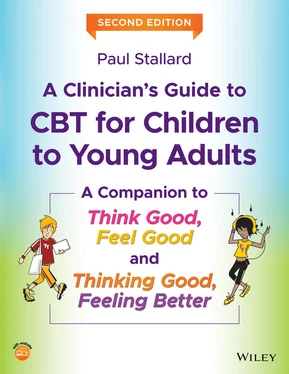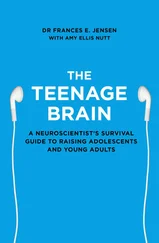CBT with younger children
Whilst CBT can routinely be used with children from the age of seven years, comparatively few studies have evaluated the effectiveness of CBT with children under the age of 12 (Ewing et al. 2015). Most studies tend to involve young adolescents aged 12–17. Randomised controlled trials evaluating CBT for the treatment of depression rarely include children under the age of 12 (Forti‐Buratti et al. 2016). For example, Yang et al. (2017) undertook a review and meta‐analysis of CBT for the treatment of depression in children (defined as under the age of 13) and identified only nine studies, with six of these being conducted before the turn of the century.
In terms of anxiety, a few specific programmes for young children have been developed. These include Being Brave (Hirshfeld‐Becker et al. 2010), Taming Sneaky Fears (Monga et al. 2015), and the school‐based universal prevention programme Fun Friends (Pahl & Barrett 2010). Results from these studies are limited but nonetheless encouraging.
A few researchers have developed and explored the effectiveness of CBT with young children with PTSD (Dalgleish et al. 2015; Salloum et al. 2016). For example, Scheeringa et al. (2011) reported the feasibility of a trauma‐focused CBT intervention with children aged three to six who had experienced a life‐threatening event and found a large reduction in PTSD symptoms at six months. Research with OCD is similarly limited, although once again the results are promising. In one of the few studies, Freeman et al. (2014) found that 72% of children aged five to eight with OCD were assessed as ‘much improved’ after completing a 14‐session family‐based CBT programme.
It cannot be assumed that because CBT is effective with young adolescents that it will also be effective with young children. Developmental factors need to be considered and the role of parents/carers requires careful attention. Nonetheless, although research is limited, the results are encouraging and are consistent with those obtained with older samples.
CBT with children and young people with learning difficulties
There is evidence that CBT can be effective with young people with learning difficulties, particularly those with high‐functioning autistic spectrum disorder (ASD; Perihan et al. 2019). For example, studies have demonstrated that CBT programmes for young people with ASD do have a beneficial effect on reducing symptoms of anxiety (Storch et al. 2013; Van Steensel & Bogels 2015; Wood et al. 2009) and OCD (Vause et al. 2018).
Researchers have highlighted how CBT needs to be modified to accommodate the young person’s specific learning difficulties (Attwood & Scarpa 2013; Donoghue et al. 2011). This involves attending to factors such as communications/language abilities, interpersonal/social abilities, cognitive and behavioural inflexibility, and sensory sensitivities (Scarpa et al. 2017). In terms of communication, adaptations might include the use of simple, precise, and concrete language and the greater use of more non‐verbal visual techniques such as pictures, worksheets, or visual prompts (e.g. writing the aim/focus of each session on a board). The young person’s special interests can be integrated into the intervention through the development of metaphors or use of rewards. Interpersonal skills with young people with ASD maybe more limited, so greater attention needs to be paid to the assessment and development of core skills such as ‘mind reading’ to aid understanding of how people might think and feel. Once again, the process can be made concrete through the use of role plays. Cognitive flexibility can be promoted using self‐talk where different options are verbalised and modelled or through multiple choice questions which encourage awareness and consideration of alternative strategies. For behavioural inflexibility, interactions during clinical sessions may need to be modified to be more consistent with the expectations of the young person. For example, Donoghue et al. (2011) note that the usual social exchanges at the start of therapy sessions may create anxiety and suggest that the therapist adopts a more task‐focused approach. Similarly, anxiety associated with change can be minimised by using the same room to meet, having a clear session routine/structure, and establishing a clear length for the meeting. In terms of sensory issues, it may be necessary to reduce the length of the session, change the lighting, remove visual material from the room, or use relaxation skills to help reduce sensory overload. Finally, generalisation from clinical sessions to the young person’s everyday environment can be facilitated through the involvement of parents, mobile phones to send prompts and reminders, and digital cameras to capture difficult situations (Donoghue et al. 2011).
Research with young people with other disorders is more limited. For visually impaired young people, tactile prompts can be used to remind the young person of the steps involved in managing anxiety (Visagie et al. 2017). For those with moderate learning difficulties, skills such as problem solving can be broken down into simple steps (Stop, Plan, Do) and limited decision‐making options (e.g. you can do either X or Y).
Technologically delivered CBT
There is increased interest in the use of technology to support and deliver CBT to children and adolescents. Technology offers the potential to reach geographically isolated populations; flexible access; increased convenience; fewer visits to specialist clinics; greater privacy and anonymity; enhanced treatment fidelity; rapid scalability; and low‐cost delivery (Clarke et al. 2015; MacDonell & Prinz 2017). It is also very acceptable and particularly appealing to adolescents, who are typically early adopters and regular users of new technologies (Johnson et al. 2015; Wozney et al. 2018).
Internet or technologically delivered CBT programmes have attracted much interest and have demonstrated encouraging results (Grist el al. 2019; Pennant et al. 2015; Vigerland et al. 2016). Digital technologies deliver interventions via computers, or through web‐based platforms via mobile tablets or smartphones (Hollis et al. 2017). The structured nature of CBT lends itself well to digital delivery, resulting in several computerised CBT interventions being developed. For example, the face‐to‐face CBT anxiety programme Cool Teens can be effective when delivered via a CD‐ROM with minimal therapist support (Wuthrich et al. 2012). Similarly, online CBT anxiety programmes such as BRAVE were found to be very acceptable to young people and as effective as face‐to‐face CBT (Spence et al. 2011). In terms of depression, encouraging results have been reported for Stressbusters , a computerised CBT program (Smith et al. 2015; Wright et al. 2017) and a computer game ( SPARX ) when used both as an intervention and as a prevention programme (Merry, Hetrick, et al. 2012; Merry, Stasiak, et al. 2012; Perry et al. 2017).
Reviews indicate that technologically delivered CBT is effective (Grist et al. 2019) and is now recommended in the United Kingdom as a first line treatment for mild to moderate depression (NICE 2019). Other technologies such as apps, virtual reality, and games have seldom been developed or evaluated.
Parents have a central role in supporting their child, and by involving them in the intervention important parental behaviours and contextual factors can be addressed. Their involvement can therefore facilitate generalisation, practice, and reinforcement of new skills in the young person’s everyday life. However, there is no consistent evidence to suggest that involving parents in CBT programmes results in better outcomes (Breinholst et al. 2012). For example, reviews have shown that CBT for anxiety is effective with and without parental involvement (Higa‐McMillan et al. 2016; Reynolds et al. 2012). Neither the age of the young person nor whether both parents are involved appears to be related to enhanced outcomes (Carnes et al. 2019; Manassis et al. 2014). Similarly, school‐based CBT anxiety prevention programmes have been found to be effective without any parental involvement (Stallard, Skryabina, et al. 2014). However, assessing the benefits of parental involvement is complex and the potential beneficial impact on parents or other family members has seldom been assessed (Breinholst et al. 2012). In addition, whilst the additional short‐term benefits may not be evident, parental involvement in CBT may support the longer‐term maintenance of treatment gains (Manassis et al. 2014).
Читать дальше












